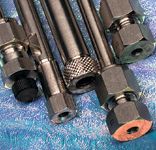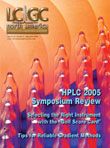A Baker's Dozen
LCGC North America
Some simple practices will help to make problems with gradient methods rare rather than frequent. this month's installment of "LC Troubleshooting" presents a baker's dozen of these tips.
There are few things more frustrating in the laboratory than having a liquid chromatography (LC) method fail after working reliably for many hundreds or thousands of injections. For some workers, gradient elution LC methods are much more prone to problems than isocratic ones. There are some tricks of the trade that experienced chromatographers practice to help ensure reliable method operation for routine gradient assays. The LC system must perform in a reliable and reproducible manner, but it does not happen by magic. Some simple practices will help to make problems with gradient methods rare rather than frequent. This month's installment of "LC Troubleshooting" presents a baker's dozen of these tips. I hope that you find them useful in lowering your frustration quotient.

LC Troubleshooting
1. Reagent Quality: Reversed-phase gradient runs tend to concentrate nonpolar materials at the head of the column and release them as the gradient progresses. Under starting gradient conditions, the mobile phase is weak (very polar, with high water content). This means that nonpolar materials will be strongly retained. Nearly any organic impurity in the mobile phase will be held at the top of the column under these conditions. During equilibration between runs, perhaps 10 or more column volumes of weak mobile phase pass through the column. While the column is equilibrating, most of the nonpolar materials in the mobile phase will concentrate at the head of the column, only to be eluted when the gradient is run. These show up as ghost peaks in the chromatogram and can make quantification difficult and confuse interpretation of the chromatogram. For this reason, it is essential to use high performance LC (HPLC)-grade reagents for gradient work. Lower quality reagents might be suitable for isocratic applications, but with gradients, even the most minor impurities can cause problems. Discard aqueous reagents and buffers frequently (for example, weekly) to avoid contamination by microbial growth. Water impurities can be problematic, so buy HPLC-grade water or use a water purification system designed for production of HPLC-grade water.
2. System Cleanliness: Just as reagent quality is important for a minimum of interfering peaks, a clean instrument also will help avoid unwanted peaks. Thoroughly flush the system with strong solvent at the end of the day or before shutting off the system. Because switching to pure organic solvent, especially acetonitrile, can cause buffers or salts to precipitate, I recommend switching to nonbuffered mobile phase first. Just replace the buffer bottle with water and run the gradient again. Run the gradient to 100% strong solvent (usually methanol or acetonitrile) and hold it at 100% for 10–15 min to thoroughly flush the column and equipment. Do not shut off a system that contains buffers or salts — either flush the system with nonbuffered mobile phase or reduce the flow rate to 0.1 mL/min. This will help avoid formation of buffer salt crystals and microbial growth in the equipment. Check valves will work more reliably and pump seals and columns will last longer with routine flushing. If you are using high-salt mobile phases (for example, > 50 mM), it is a good idea to use the seal-wash feature of your system to flush water behind the pump seals to remove any buffers or salts that leak past the seal. Clean up spills, leaks, and other potential sources of contamination. Be sure to wash or replace solvent reservoirs on a regular basis (for example, weekly).

John W. Dolan
3. Sample Cleanup: When asked how to make columns last forever, my usual answer is to never make an injection. That makes it hard to get our work done, so the next best thing is to inject clean samples. As a rule, the cleaner the samples are, the longer the column will last and the more reliable the method will be. There must be a balance, however, because it is possible to spend more time and money cleaning up the sample than you save in reliability and extended column life. You will have to figure out the economics of that yourself. However, for all methods, it is a good idea to avoid injecting any sample that contains particulate matter. Some workers like to filter samples with a syringe filter. I work primarily in the pharmaceutical industry and tend to question the value of filtering every sample. The syringe filters are expensive — a dollar or more each. Plus, you must validate the filtration process. Are any sample components selectively removed by the filter? Are any contaminants added to the sample by the filter? How much sample volume is lost during filtration? These and other questions make me want to avoid filtration. Instead, I like to centrifuge the samples in a benchtop centrifuge for a few minutes (for example, 10,000–15,000 rpm for 5 min). This settles out particulate matter that can clog column frits. Transfer the sample to a clean vial before injection. I am also a strong advocate of mounting a 0.5-μm in-line frit just downstream from the autosampler. This will trap any junk that would normally block the 2-μm frit at the top of the column and can be changed much more easily than the column frit.
4. Degassing: Although some gradient LC systems will operate without degassing the mobile phase, every system will operate more reliably with degassed solvents. Trapped air bubbles and solvent outgassing are two of the most common problems with gradients, and these can be largely avoided by solvent degassing. Bubbles in the pump(s) cause pressure and flow fluctuations, which can distort the gradient shape and affect retention times. Helium sparging has been the gold standard for degassing for many years, but many of today's LC systems come with in-line vacuum degassers that are much easier to use and provide effective gas removal. It is a good idea to purge the pump(s) and solvent inlet lines daily by opening the purge valve(s) and operating at an elevated flow rate (for example, 5 mL/min) for a few minutes to remove any air bubbles that might have accumulated while the system was shut off.
5. Blank Gradient: I recommend running a blank gradient as part of method setup to ensure that unexpected drift, noise, or peaks are not present. Simply set the autosampler to bypass the injection and run a normal gradient. (The systems in my laboratory can be programmed to make a zero-volume injection to accomplish this.) Look for peaks in the blank chromatogram. These come from reagent or water impurities. For methods run at maximum system sensitivity, it might not be possible to obtain completely smooth baselines, but the number of spurious peaks should be kept to a minimum and none should be eluted at the same retention time as sample components of interest. Although blank gradients might not be required on a daily basis for a routine method, the blank run is inexpensive insurance to help protect against loss of valuable sample data.
6. Dedicated Columns: Each analytical method should have a column dedicated to that method. I strongly advise against sharing columns between methods, because unimportant peaks in one method can cause interferences in a second method. Dedicated columns last longer, so fewer columns will need to be purchased in the long run if each method has its own column. While we are talking about columns, remember that a column is a consumable item — it should not be expected to last forever. In my experience, with a well designed method, a column should last for at least 500 injections, even under severe mobile phase conditions. This amounts to < 5% of the cost of analysis and usually is much less than the cost of other consumable items, such as solid-phase extraction cartridges. With adequate sample pretreatment and nonaggressive mobile phases, it is not unusual for a column to last for 2000 samples or more.
7. Equilibration: Before each run, the column should be equilibrated to the same extent as the other injections in the run sequence. A good rule of thumb is to allow 10 column volumes of the initial mobile phase to pass through the column for equilibration between runs. For the most common column, 150 mm × 4.6 mm, the column volume is approximately 1.5 mL, so 15–20 mL should be sufficient. Remember that during equilibration and column washing, volume is more important than time, so the equilibration time might be shortened by increasing the flow rate during this phase of the method. Recent information (for example, reference 1) shows that complete equilibration might or might not be necessary, as long as the same amount of equilibration is used between every run. Operating under partial equilibration conditions can save time by shortening the wait between injections.
8. Check It Out: It is a good idea to carefully examine the LC system each day before starting routine injection of samples. A good time to do this is during the initial equilibration of the column with a new batch of mobile phase. Just start at the mobile phase reservoirs and trace the solvent feed tubing through the mixer, connecting tubing, pump, and so forth on to the waste bottle after the detector. Are there any leaks? Is there white fuzz on any of the fittings? Do the reservoirs contain sufficient mobile phase? Is the autosampler wash solvent level sufficient? Does the waste solvent bottle have room for the anticipated waste stream? Is there anything else about the system that does not look, smell, or sound right? A few minutes each day spent examining the system pays great dividends when minor problems can be identified and corrected before they grow to the extent that they will compromise analytical results.
9. Priming Injections: Some methods will give better results if several "priming" injections are made before the first sample is injected. These injections of standards or mock samples can help to load slowly equilibrating active sites on the column so that more reproducible separations can be obtained. If you notice that it takes several runs before the retention time or peak area stabilizes, your method might be a candidate for priming injections. You can make a special priming solution that contains the analytes at high concentration or make several large volume injections at a lower concentration to load enough sample on the system to deactivate the column. Sometimes the system suitability injections serve as priming injections. Most methods do not require priming injections, but if your method does, this procedure reduces the time it takes to get reliable data from the system.
10. Ignore the First Injection: Because some methods require the priming process (see above) and the first injection can be equilibrated differently than subsequent injections, I advise setting up a routine method so that the first injection is not used for quantitative purposes. The second and subsequent runs will be more reliable than the first injection. By making it a formal practice to ignore the first injection, you will not have the hassle of having to perform outlier tests or other procedures to justify throwing out the first injection when it does not meet method criteria.
11. System Suitability: Many methods that run under the oversight of regulatory agencies (FDA, EPA, OECD, and others) will require a system suitability test before sample analysis. System suitability serves as a mini-validation to show that the equipment and analytical method are operating in a fashion that will produce reliable results. Requirements for system suitability tests vary, so the regulatory guidelines should be consulted to help select appropriate tests. Many workers use retention time, retention and area reproducibility, peak response, peak width, peak tailing, resolution, and column back pressure either alone or in combination as part of the system suitability test. The system suitability sample might be a diluted pure standard, a mock sample in extracted matrix, or some other sample selected to demonstrate system performance. Whether or not a system suitability test is required, I strongly suggest running such tests before routine analysis, even if it is just an injection of a standard to see if the retention and peak size are as expected.
12. Standards and Calibrators: For quantitative analysis, the response of unknown samples is compared with the response for standards of known concentration. The range of standard concentrations, number of replicates, and sequence of injection will depend upon the specific application. External or internal standardization might be appropriate. In any event, running at least one standard before running unknown samples will provide assurance (system suitability) that the analytical method is working properly before potentially valuable samples are injected.
13. Quality Control Samples: Analytical methods operated under regulatory oversight can require inclusion of quality control (QC) samples. QC samples are mock samples made in the sample matrix at known concentrations. Their concentration is calculated against the standard calibrators as a check to show that the method is operating in a manner that will produce reliable results. Generally, it is wise to intersperse QC samples among unknown samples to demonstrate that reliable results can be obtained throughout an analytical run. The results of QC samples can be tracked over time with a control chart. Sometimes the control chart can be helpful in anticipating failure of the system or identifying subtle problems.
Conclusions
You might realize that these tips for reliable gradient method operation already are part of your routine, either in whole or in part. Or you may have other techniques you use to ensure that the system is ready for samples. Send me an e-mail to share your favorite practices. Whether required by regulations or not, you will find that your gradient methods will be much more trouble-free if you take a few minutes before injecting the first sample to make sure that the system is ready to go.
John W. Dolan "LC Troubleshooting" Editor John W. Dolan is Vice-President of BASi Northwest Laboratory of McMinnville, Oregon; a Principal Instructor for LC Resources, Walnut Creek, California; and a member of LCGC's editorial advisory board. Direct correspondence about this column to "LC Troubleshooting," LCGC, Woodbridge Corporate Plaza, 485 Route 1 South, Building F, First Floor, Iselin, NJ 08830, e-mail John.Dolan@Bioanalytical.com
References
(1) A.P. Schellinger, D.R. Stoll, and P.W. Carr, J. Chromatogr., A 1064, 143 (2005).
Reversed-Phases for LC Deliberately Doped with Positive Charge: Tips and Tricks for Effective Use
May 13th 2025In this month's edition of LC Troubleshooting, Dwight Stoll and his fellow researchers discuss both the benefits (improved peak shape/loading) and challenges (excessive interaction) associated with charge-doped reversed-phase (RP) columns for both analytical and preparative separations.
Investigating 3D-Printable Stationary Phases in Liquid Chromatography
May 7th 20253D printing technology has potential in chromatography, but a major challenge is developing materials with both high porosity and robust mechanical properties. Recently, scientists compared the separation performances of eight different 3D printable stationary phases.
Characterizing Polyamides Using Reversed-Phase Liquid Chromatography
May 5th 2025Polyamides can be difficult to characterize, despite their use in various aspects of everyday life. Vrije Universiteit Amsterdam researchers hoped to address this using a reversed-phase liquid chromatography (RPLC)-based approach.

.png&w=3840&q=75)

.png&w=3840&q=75)



.png&w=3840&q=75)



.png&w=3840&q=75)












